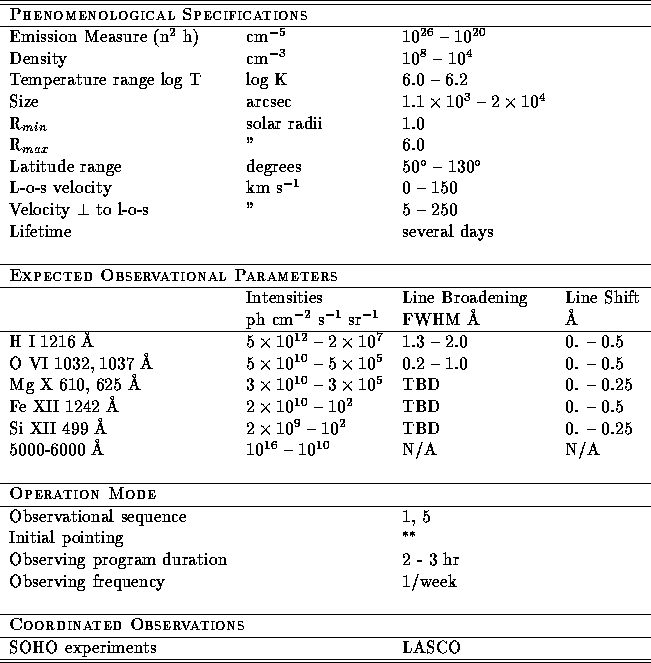 appears very interesting, particularly because it can be
correlated with the measurements carried out by the in situ
instruments on board SOHO, which will establish the asymptotic properties
of the expanding atmosphere.
appears very interesting, particularly because it can be
correlated with the measurements carried out by the in situ
instruments on board SOHO, which will establish the asymptotic properties
of the expanding atmosphere.




We propose to investigate the dynamics of protons and some heavy ions (N V, O VI, Mg X and Si XII) in solar wind acceleration regions, in particular in coronal holes, by determining the outflow velocity of these particles at various heliocentric distances and, for a given heliocentric distance, selecting different points along the instantaneous field of view of the spectrometer.
Several theoretical models of the coronal regions where the solar wind is
accelerated predict that there the outflow velocity of heavy ions can be
significantly lower than that of protons (e.g., Bürgi and Geiss 1986;
Esser and Leer 1990). On the other hand, in situ measurements of the
solar wind plasma show that at 1 A.U. heavy ions travel as fast or faster
than protons (see, e.g., Ogilvie et al. 1982). Therefore the
observation of some key ions gaining momentum in the coronal regions within
5 R appears very interesting, particularly because it can be
correlated with the measurements carried out by the in situ
instruments on board SOHO, which will establish the asymptotic properties
of the expanding atmosphere.
appears very interesting, particularly because it can be
correlated with the measurements carried out by the in situ
instruments on board SOHO, which will establish the asymptotic properties
of the expanding atmosphere.
The outflow velocity of protons and ions can be determined by estimating the Doppler dimming effect on the spectral lines observed, as described by Kohl and Withbroe (1982). Moreover, Noci et al. (1987) have proposed a method for determining the outflow velocity of the O VI ions by measuring the intensity ratio of the two resonance doublet lines at several heliocentric distances. This method is more direct and does not depend on the instrument photometric calibration or the ionization balance of oxygen.
The velocity
profile of the oxygen ions, using the O VI  1038/
1038/ 1032 intensity ratios,
can be suitably representative of the
dynamic behaviour of heavy ions (see the calculations of Bürgi and
Geiss (1986)).
Ly--
1032 intensity ratios,
can be suitably representative of the
dynamic behaviour of heavy ions (see the calculations of Bürgi and
Geiss (1986)).
Ly-- Doppler dimming can
indicate the differences between the outflow velocities of
protons and oxygen ions.
To obtain more reliable measurements,
we prefer to limit the observations to polar coronal holes, whose
brightness in UV lines is affected by line--of--sight effects much less
than that of coronal holes at lower latitudes.
Doppler dimming can
indicate the differences between the outflow velocities of
protons and oxygen ions.
To obtain more reliable measurements,
we prefer to limit the observations to polar coronal holes, whose
brightness in UV lines is affected by line--of--sight effects much less
than that of coronal holes at lower latitudes.
The morphology and evolution of the selected coronal hole can be recorded
by LASCO.
Dynamics of Protons and Heavy Ions in Solar Wind Acceleration Regions

 Place the slit tangential to the limb, centered on the axis of symmetry
of the considered region, pointing at 1.2 R
Place the slit tangential to the limb, centered on the axis of symmetry
of the considered region, pointing at 1.2 R . Move the telescope
spanning the observed region in heliocentric distance (step=0.1 R
. Move the telescope
spanning the observed region in heliocentric distance (step=0.1 R within 2 R
within 2 R , 0.2 R
, 0.2 R within 3 R
within 3 R , 0.5 R
, 0.5 R for larger heliocentric distances). Beyond 3 R
for larger heliocentric distances). Beyond 3 R , it may be
necessary to rotate the field of view around the sun center axis to observe
the regions close to the boundaries of the coronal hole.
, it may be
necessary to rotate the field of view around the sun center axis to observe
the regions close to the boundaries of the coronal hole.



